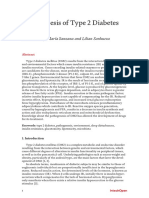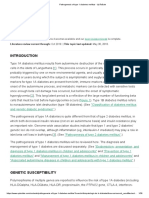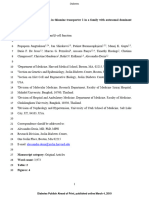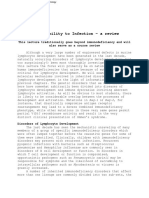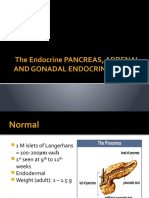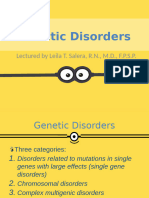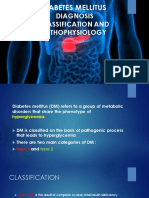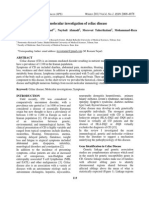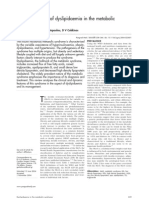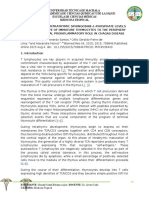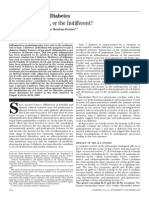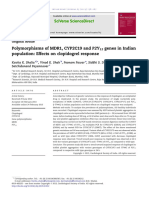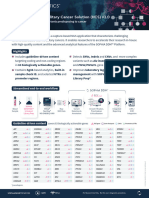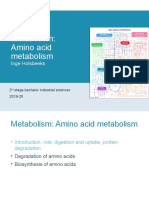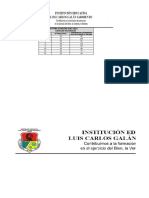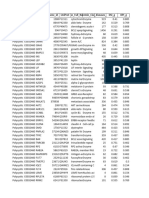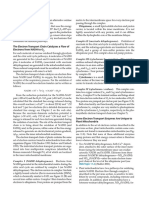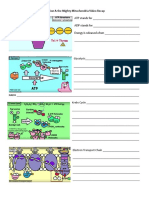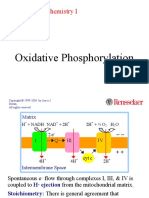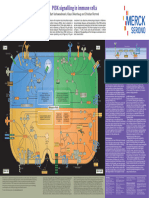0 ratings0% found this document useful (0 votes)
7 viewsLec D.M.
Lec D.M.
Uploaded by
liathmahmood15Copyright:
© All Rights Reserved
Available Formats
Download as PPT, PDF, TXT or read online from Scribd
Lec D.M.
Lec D.M.
Uploaded by
liathmahmood150 ratings0% found this document useful (0 votes)
7 views39 pagesOriginal Title
lec D.M.
Copyright
© © All Rights Reserved
Available Formats
PPT, PDF, TXT or read online from Scribd
Share this document
Did you find this document useful?
Is this content inappropriate?
Copyright:
© All Rights Reserved
Available Formats
Download as PPT, PDF, TXT or read online from Scribd
Download as ppt, pdf, or txt
0 ratings0% found this document useful (0 votes)
7 views39 pagesLec D.M.
Lec D.M.
Uploaded by
liathmahmood15Copyright:
© All Rights Reserved
Available Formats
Download as PPT, PDF, TXT or read online from Scribd
Download as ppt, pdf, or txt
You are on page 1of 39
THIRD STAGE: Endocrine unit 10 (WK
4)
Genetics and Immuno-
pathogenetics of Diabetes Mellitus
Dr. Sawsan Mohammed Jabbar AL-Hasnawi
University of Kerbala / College of Medicine / Department of Medical
Microbiology
By the end of this lecture, you
should be able to:
1. identify the immuno-pathogenesis
of DM.***
2. summarize the immuno-genetics of
DM.***
3. differentiate between immune and
nonimmune genetics of diabetes.***
Immunopathogenesis of DM
Type 1 diabetes is an autoimmune
disorder in which the body attacks its
pancreatic beta cells.
The onset of type 1 diabetes is
attributed to both an inherited risk
and external triggers, such as diet or
an infection.
Type 1 diabetes appears to develop as the
consequence of an imbalance between
pathogenic and regulatory T lymphocytes.
CD4+ T cells and CD8+ T cells appear to
mediate beta cell destruction. CD8+ T
lymphocytes are capable of destroying beta
cells by the release of granules containing
granzyme or perforin or via Fas-ligand
interactions.
Circulating T lymphocytes directed against
a wide range of islet antigens have been
identified, these are called islet
autoantibodies.
Markers of the immune destruction of
the β-cell include islet cell
autoantibodies(ICA), autoantibodies to
insulin(IAA) , autoantibodies to
glutamic acid decarboxylase (GAD65),
autoantibodies to the tyrosine
phosphatases IA-2A and IA-2β and
Zinc transporter 8 antibodies (ZnT8).
One and usually more of these
autoantibodies are present in 85–90%
of individuals when fasting
hyperglycemia is initially detected.
Type 1 Diabetes (T1D) Genetics
Genetics of IDDM
About 18 regions of the genome have
been linked with influencing type 1
diabetes risk.
These regions, each of which may
contain several genes, have been
labeled IDDM1 to IDDM18.
Genome Screens for T1D
IDDM1 6p21 IDDM13 2q34-q35
IDDM2 11p15 IDDM14 Not yet proved
IDDM3 15q26 IDDM15 6q21
IDDM4 11q13 IDDM16 Not yet proved
IDDM5 6q25-q27 IDDM17 10q25
IDDM6 18q21 IDDM18 5q31-q33
IDDM7 2q31
IDDM8 6q27-qter
IDDM9 3q21-q25
IDDM10 10p11-q11
IDDM11 14q24-q31
IDDM12 2q33
The most well studied is IDDM1,
which contains the HLA genes that
encode immune response proteins.
There are two other non-HLA genes
which have been identified thus far.
One of these non-HLA genes, IDDM2,
is the insulin gene, and the other non-
HLA gene maps close to IDDM12
(CTLA4), which has a regulatory role
in the immune response.
IDDM1 Contains the HLA
Genes
The HLA region is a cluster of genes on
chromosome 6. The genes encode
glycoproteins that are found on the
surfaces of most cells and help the immune
system to distinguish between self (its own
cells, e.g., beta cells of the pancreas) and
non-self (e.g., bacteria, viruses).
HLA alleles may increase the risk of
diabetes, have no effect, or even be
protective.
The HLA genes encode proteins called major
histocompatibility complex (MHC), and there
are two main classes of MHC proteins, Class
I MHC and MHC class II. If T cells bind to
the chain of amino acids that presented on
an MHC, the T cell immediately orchestrates
powerful attacks by the body's other
immune cells.
Ideally, the body only contains T cells that
bind to chains from infectious organisms
(viruses, bacteria, etc.) and tumor cells.
The alternative is found in autoimmune
diseases such as diabetes: T cells bind to
chains from the body's healthy cells.
There are many different alleles of the
HLA genes, leading to many different
variants of MHC proteins and allowing a
variety of chains to be presented to cells.
The inheritance of particular HLA alleles
can account for over half of the genetic
risk of developing type 1 diabetes.
The genes encoding class II MHC proteins
are most strongly linked with diabetes, and
these genes are called HLA-DP, HLA-DQ,
and HLA-DR.
In the general population, only half of the
people inherit a copy (allele) of DR gene
called DR3 and DR4, and less than 3% of
the people have two alleles.
However, in type 1 diabetes at least one
allele of DR3 or DR4 is found in 95% of
Caucasians, and individuals with both DR3
and DR4 are particularly susceptible to
type 1 diabetes.
Conversely, the DR2 allele is protective
Similar to the DR gene, certain alleles
of the DQ gene are risk factors for
developing the disease, whereas other
alleles of DQ are protective.
There is also a tendency for people
who inherit DR3 or DR4 to inherit
DQ, which adds to their genetic risk
of developing diabetes.
Conversely, the protective alleles of
DR and DQ tend to be inherited
together.
The IDDM1 locus contains many
diabetes susceptibility genes, the
two alleles DQB1 and DRB1 are
the most important.
One of the protective HLA
haplotypes is DQA1*0102,
DQB1*0602.
MHC Region – Chromosome 6p21
IDDM2
Insulin(INS) gene
Chromosome 11p15.
Several single nucleotide
polymorphisms (SNPs) have been
found within the INS gene, of
which cause non-synonymous
amino acid changes in the mature
protein .
IDDM12
Cytotoxic T Lymphocyte
Associated-4 (CTLA-4)
Chromosome 2q33.
Encodes a T cell receptor that plays
role in T cell apoptosis
Dysfunction of CTLA-4 is
consistent with development of T1D
IDDM12
When the T cell is presented with a chain
of amino acids, its T-cell receptor binds to
the HLA molecules that are presenting the
chains.
For the T cell to become fully activated,
there is additional signaling between co-
stimulatory receptors and corresponding
ligands on the antigen-presenting cell.
These co-stimulatory receptors are
encoded by the candidate genes for type 1
diabetes susceptibility CTLA4.
Other Type 1 Diabetes Susceptibility Loci:
IDDM3–IDDM18
Type 2 Diabetes (T2D) Genetics
Type 2 Diabetes
Is group of genetically heterogeneous
metabolic disorders that cause glucose
intolerance
– Involves impaired insulin secretion
and/or insulin action
~90% of individuals with diabetes have
T2D
Polygenic and multifactorial
– Caused by multiple genes that may
interact
– Caused by genetic and environmental risk
factors
Genetics and T2D
Individuals with a positive family history are about
2-6 times more likely to develop T2D than those
with a negative family history
– Risk ~40% if T2D parent; ~80% if 2 T2D
parents
Higher concordance for MZ versus DZ twins
Has been difficult to find genes for T2D
– Late age at onset
– Polygenic inheritance
– Multifactorial inheritance
in type 2 diabetes, many genes are
thought to be involved. "Diabetes
genes" may show only a subtle
variation in the gene sequence, and
these variations may be extremely
common.
The difficulty lies in linking such
common gene variations, known as
single nucleotide polymorphisms
(SNPs), with an increased risk of
developing diabetes.
1.The Sulfonylurea Receptor
(ABCC8)
Sulfonylureas are a class of drugs used
to lower blood glucose in the treatment
of type 2 diabetes. These drugs interact
with the sulfonylurea receptor of
pancreatic beta cells and stimulate
insulin release.
The sulfonylurea receptor is encoded by
the ABCC8 gene, and genetic variation of
ABCC8 may impair the release of insulin.
2.The Insulin Hormone
(INS)
The INS gene encodes the precursor
to the hormone insulin. Genetic
variations of the insulin gene (variable
number tandem repeats and SNPs)
may play a role in susceptibility to
type 1 and type 2 diabetes.
3.The Calpain 10 Enzyme
(CAPN10)
Calpain 10 is a calcium-activated
enzyme that breaks down proteins.
A genetic variant of CAPN10 may
alter insulin secretion, insulin action,
and the production of glucose by the
liver.
4.The Glucagon Receptor
(GCGR)
Glucagon is a key hormone in the
regulation of glucose levels.
As such, the GCGR gene which
encodes its receptor is a candidate
diabetes susceptibility gene. A
mutant glucagon receptor has been
associated with diabetes.
5.The Enzyme Glucokinase (GCK)
6.The Glucose Transporter GLUT2
7.The Transcription Factor HNF4A
8.The Insulin Receptor (INSR)
9.The Potassium Channel KCNJ11
10.The Enzyme Lipoprotein Lipase
(LPL)
11.The Transcription Factor PPARG
12.The Regulatory Subunit of a
Phosphorylating Enzyme (PIK3R1)
Maturity Onset Diabetes of
the Young (MODY) Genetics
MODY
Account for ~ 5% of type 2 diabetes
Single gene defects
– Autosomal dominant inheritance
– Multiple generations affected
Early age at onset (< age 25 years)
Characterized by the absence of obesity, no
ketosis and no evidence of beta cell
autoimmunity
MODY Genes
No. %
Type Gene Locus Protein Mutations MODY
MODY1 HNF4A 20q12-q13.1 Hepatocyte nuclear 12 ~5%
factor 4-alpha
MODY2 GCK 7p15-p13 Glucokinase ~200 ~15%
MODY3 HNF1A 12q24.2 Hepatocyte nuclear >100 ~65%
factor 1-alpha
MODY4 IPF1 13q12.1 Insulin promotor Few
factor-1
MODY5 HNF1B 17cen-q21.3 Hepatocyte nuclear Few <3%
factor 1-beta
MODY6 NEUROD1 2q32 Neurogenic Few
differentiation factor
1
references
The Genetic landscape of diabetes.
Laura Dean, MD and Jo McEntyre,
PhD.
You might also like
- Calisthenics Mass - How To Maximize Muscle Growth Using Bodyweight-O.Document173 pagesCalisthenics Mass - How To Maximize Muscle Growth Using Bodyweight-O.hung40% (25)
- Type 1 Diabetes Mellitus POSTERDocument1 pageType 1 Diabetes Mellitus POSTERLeandro FigueiraNo ratings yet
- Pathogenesis of Type 2 Diabetes Mellitus: Pilar Durruty, María Sanzana and Lilian SanhuezaDocument18 pagesPathogenesis of Type 2 Diabetes Mellitus: Pilar Durruty, María Sanzana and Lilian SanhuezaLouise Clemente DoroteoNo ratings yet
- DR - Rihab Pediatrics 01.pediatric DM Part OneDocument11 pagesDR - Rihab Pediatrics 01.pediatric DM Part OneMujtaba JawadNo ratings yet
- Pathogenesis of Type 1 Diabetes MellitusDocument28 pagesPathogenesis of Type 1 Diabetes MellitusJuan Diego Fernández MurielNo ratings yet
- Jak Stat InhibitorsDocument64 pagesJak Stat InhibitorsSupratim KarmakarNo ratings yet
- Pancreatic Gland Disorders CompleteDocument58 pagesPancreatic Gland Disorders CompletejawadNo ratings yet
- Edrv 0190Document33 pagesEdrv 0190Mashfiqul HasanNo ratings yet
- Genetic Polymorphism in Drug MetabolismDocument55 pagesGenetic Polymorphism in Drug MetabolismMounika16 Pedamallu100% (2)
- Durruty, Et Al (2019) Pathogenesis of Type 2 DiabetesDocument19 pagesDurruty, Et Al (2019) Pathogenesis of Type 2 Diabetestantry puspitasariNo ratings yet
- Reviews: Circulating Micrornas As Novel Biomarkers For Diabetes MellitusDocument9 pagesReviews: Circulating Micrornas As Novel Biomarkers For Diabetes MellitusLintangNAnggraeniNo ratings yet
- Activation of Nrf2 Signaling by Natural Products-Can It Alleviate DiabetesDocument30 pagesActivation of Nrf2 Signaling by Natural Products-Can It Alleviate DiabetesDra. Ianna CarmoNo ratings yet
- Classification of Diabetes Mellitus - Endotext - NCBI BookshelfDocument11 pagesClassification of Diabetes Mellitus - Endotext - NCBI BookshelfSwati ParijaNo ratings yet
- Diabetes Mellitus PresentationDocument178 pagesDiabetes Mellitus PresentationMelesNo ratings yet
- Immunoinformatics in DiabetesDocument8 pagesImmunoinformatics in DiabetesMio CaguiclaNo ratings yet
- Review Article: Biomarkers For Type 1 DiabetesDocument19 pagesReview Article: Biomarkers For Type 1 Diabetessalman672003No ratings yet
- Cellular Signaling in Diabetes and CancerDocument20 pagesCellular Signaling in Diabetes and Cancerirumanwaar2001No ratings yet
- CMNA0115Document241 pagesCMNA0115Alex MarinNo ratings yet
- Celiac DZ - PedsDocument12 pagesCeliac DZ - PedsbencleeseNo ratings yet
- EATLDocument8 pagesEATLJelena DjekicNo ratings yet
- 2019 - Loss-of-Function Mutation in Thiamine Transporter 1 in A Family With Autosomal Dominant DiabetesDocument41 pages2019 - Loss-of-Function Mutation in Thiamine Transporter 1 in A Family With Autosomal Dominant DiabetesSimon SaundersNo ratings yet
- Etiopathogenesis of Diabetes MellitusDocument35 pagesEtiopathogenesis of Diabetes MellitusironNo ratings yet
- Gen Sus InfectDocument20 pagesGen Sus InfectJahuey UnalescoNo ratings yet
- The Endocrine Pancreas IIDocument134 pagesThe Endocrine Pancreas IIHoque Mohammed Newaz ShorifulNo ratings yet
- Emerging Therapeutic Options in The Management of Diabetes Recent Trends, Challenges and Future DirectionsDocument21 pagesEmerging Therapeutic Options in The Management of Diabetes Recent Trends, Challenges and Future DirectionsGabriela Pacheco100% (1)
- DM C1 Lecture EditedDocument119 pagesDM C1 Lecture EditedAhmed KitawNo ratings yet
- 2023 Pharmacogenomics Diabetes FAA - 240118 - 071252Document24 pages2023 Pharmacogenomics Diabetes FAA - 240118 - 071252Maryam HaniniNo ratings yet
- Diabetes Mellitus: DefinitionDocument54 pagesDiabetes Mellitus: DefinitionislamnourNo ratings yet
- Genetics of DM-GCDocument7 pagesGenetics of DM-GCHaseena SaitNo ratings yet
- 001 ppt-1 PDFDocument60 pages001 ppt-1 PDFniallvvNo ratings yet
- Utsav2, Et AlDocument16 pagesUtsav2, Et Alnadin nNo ratings yet
- MIDTERM Dr. Salera III. Genetic DisordersDocument74 pagesMIDTERM Dr. Salera III. Genetic Disordersdelarrazabal.carlosjaimeNo ratings yet
- Neonatal Diabetes Mellitus - UpToDateDocument17 pagesNeonatal Diabetes Mellitus - UpToDateW.R. M.N.No ratings yet
- Diabetes 1Document22 pagesDiabetes 1aparna shamaNo ratings yet
- The Molecular Investigation of Celiac DiseaseDocument7 pagesThe Molecular Investigation of Celiac DiseasesserggiosNo ratings yet
- Fast Facts: Familial Chylomicronemia Syndrome: Raising awareness of a rare genetic diseaseFrom EverandFast Facts: Familial Chylomicronemia Syndrome: Raising awareness of a rare genetic diseaseNo ratings yet
- Fisiopatologia Sindrome MetabolicoDocument9 pagesFisiopatologia Sindrome MetabolicoEmilio MoncadaNo ratings yet
- Genetic GravesDocument12 pagesGenetic GravesDavina ShalsabillaNo ratings yet
- Maturity-Onset Diabetes of The Young (MODY) : Genetic and Clinical CharacteristicsDocument5 pagesMaturity-Onset Diabetes of The Young (MODY) : Genetic and Clinical CharacteristicsSarah AgustinNo ratings yet
- Perspective: C. Gilor, S.J.M. Niessen, E. Furrow, and S.P. DibartolaDocument14 pagesPerspective: C. Gilor, S.J.M. Niessen, E. Furrow, and S.P. DibartolaLeydi CarreñoNo ratings yet
- Diabetes MellitusDocument43 pagesDiabetes MellitusRobi HSNo ratings yet
- Status and Prospects For The Fight Against Diabetes MellitusDocument6 pagesStatus and Prospects For The Fight Against Diabetes Mellitusgustavoiceland2022No ratings yet
- Diabetes Gene Therapy1Document22 pagesDiabetes Gene Therapy1EINSTEIN2DNo ratings yet
- Ana Flávia Nardy Leonardo Santos Célio Geraldo Freire-de-Lima Alexandre Morrot 10.1155/2015/709846Document12 pagesAna Flávia Nardy Leonardo Santos Célio Geraldo Freire-de-Lima Alexandre Morrot 10.1155/2015/709846Glenda B AjilaNo ratings yet
- Jurnal BundaDocument10 pagesJurnal BundaNiko Hizkia SimatupangNo ratings yet
- Hdac Inhibition As A Novel Treatment For Diabetes MellitusDocument14 pagesHdac Inhibition As A Novel Treatment For Diabetes MellitusgreatmaleksNo ratings yet
- Pharmacogenetics 141110022651 Conversion Gate01Document45 pagesPharmacogenetics 141110022651 Conversion Gate01Jeevan Khanal0% (1)
- DiabetesDocument352 pagesDiabetesbeltonNo ratings yet
- Zafran UllahDocument13 pagesZafran UllahMueez BalochNo ratings yet
- IMS - Immunomodulation & ImmunodeficienciesDocument3 pagesIMS - Immunomodulation & ImmunodeficienciesJeanne RodiñoNo ratings yet
- Genetics of Type 2 Diabetes - PMCDocument16 pagesGenetics of Type 2 Diabetes - PMCGryes MesNo ratings yet
- Diabetic PatientDocument16 pagesDiabetic PatientGabii OrdoñezNo ratings yet
- Il6 Dan DiabetesDocument11 pagesIl6 Dan DiabetesAdjie KurniajiNo ratings yet
- ?SNP ReportDocument32 pages?SNP ReportDaria PankratovaNo ratings yet
- 2015 Association of TCF7L2 Gene Polymorphisms With Susceptibility To Type 2 Diabetes Mellitus in A Chinese Hui PopulationDocument8 pages2015 Association of TCF7L2 Gene Polymorphisms With Susceptibility To Type 2 Diabetes Mellitus in A Chinese Hui PopulationFiqih NurkholisNo ratings yet
- 1 s2.0 S0019483213000382 MainDocument10 pages1 s2.0 S0019483213000382 Mainsiddhi divekarNo ratings yet
- Mitochondrial Diabetes in Children Seek and You WillDocument8 pagesMitochondrial Diabetes in Children Seek and You WillsarijuicyNo ratings yet
- Genetic DisordersDocument23 pagesGenetic DisordersAqib IshaqNo ratings yet
- LiverDisease With LinksDocument20 pagesLiverDisease With LinksgeorgescumirelaligiaNo ratings yet
- Transcriptomic and Proteomic Analysis of Potential Therapeutic Target Genes in The Liver of Metformin Treated Sprague Dawley Rats With Type 2 Diabetes Mellitusijmm-41!06!3327Document15 pagesTranscriptomic and Proteomic Analysis of Potential Therapeutic Target Genes in The Liver of Metformin Treated Sprague Dawley Rats With Type 2 Diabetes Mellitusijmm-41!06!3327ErickNo ratings yet
- Acer Aspire A315 Series Huaqin NB8609 Rose GL BoardView PDFDocument2 pagesAcer Aspire A315 Series Huaqin NB8609 Rose GL BoardView PDFvillavicenciojavier790No ratings yet
- SOPHiA DDM™ HCS v2.0 Flyer - GL-GN-2300065-r2Document2 pagesSOPHiA DDM™ HCS v2.0 Flyer - GL-GN-2300065-r2WissamMamouNo ratings yet
- T Cell - WikipediaDocument65 pagesT Cell - WikipediaPowell KitagwaNo ratings yet
- Mapa de Rutas MetabolicasDocument1 pageMapa de Rutas MetabolicasHarmando Frankho Hacoltsi HernanndesNo ratings yet
- NTR 314, Examll3Document1 pageNTR 314, Examll3bayoubelle7774285No ratings yet
- Q2 ELS L4 Cellular RespirationDocument30 pagesQ2 ELS L4 Cellular RespirationJoshNo ratings yet
- Handwritten Biochem U-2 NOTESDocument31 pagesHandwritten Biochem U-2 NOTESGayatri TiwaskarNo ratings yet
- Electron Transport Chain - DETAILED Part 2 AtfDocument1 pageElectron Transport Chain - DETAILED Part 2 AtfOliwiaNo ratings yet
- 7amino Acid MetabolismDocument35 pages7amino Acid Metabolismsabasaktir4142No ratings yet
- Competencias CienciasDocument202 pagesCompetencias CienciasJohn Jairo Guzman RoldanNo ratings yet
- ETC Part Three Illustration AtfDocument1 pageETC Part Three Illustration Atfpnsscsny29No ratings yet
- Data MentahDocument2 pagesData MentahYudha Nugraha PrakosaNo ratings yet
- C0032460 Disease Gda SummaryDocument44 pagesC0032460 Disease Gda Summarydcruze.exeNo ratings yet
- Pex 02 07Document7 pagesPex 02 07Drax The destroyerNo ratings yet
- Pengantar MetabolismeDocument19 pagesPengantar MetabolismeHildya KusmiNo ratings yet
- 3.6.4.1 Principles of Homeostasis and Negative FeedbackDocument33 pages3.6.4.1 Principles of Homeostasis and Negative Feedbacktomtinoy2019No ratings yet
- Plant-Physiology by TAIZ and ZEIGER PDFDocument2 pagesPlant-Physiology by TAIZ and ZEIGER PDFshxxxNo ratings yet
- Amoeba SistersDocument2 pagesAmoeba Sistersapi-323720899No ratings yet
- Citric Acid CycleDocument28 pagesCitric Acid CycleSofi AmaliaNo ratings yet
- Oxidative Phosphorylation: Molecular Biochemistry IDocument39 pagesOxidative Phosphorylation: Molecular Biochemistry IDozdiNo ratings yet
- Price List AAM 2012Document277 pagesPrice List AAM 2012CV Tri R FamiliNo ratings yet
- BCH361 - Course OutlineDocument2 pagesBCH361 - Course OutlineEmilija BjelajacNo ratings yet
- Electron Transport ChainDocument18 pagesElectron Transport ChainArlyn Pasion BungbongaNo ratings yet
- Advanced Biochemistry: The Krebs CycleDocument11 pagesAdvanced Biochemistry: The Krebs CycleMaritsa PerHerNo ratings yet
- Human HT 12 V 4Document2,566 pagesHuman HT 12 V 4R RNo ratings yet
- Aerobic Respiration: Chemiosmosis and Electron Transport ChainDocument17 pagesAerobic Respiration: Chemiosmosis and Electron Transport ChainAihk kenneth BaronaNo ratings yet
- Javier Guajardo 2023 05 25 0949Document2 pagesJavier Guajardo 2023 05 25 0949Fernanda QuevedoNo ratings yet
- Rx24citricacidcycle 1Document28 pagesRx24citricacidcycle 1Rahmanida SusianaNo ratings yet
- PI3K Signalling in Immune Cells 07Document1 pagePI3K Signalling in Immune Cells 07Sonia Barbosa CornelioNo ratings yet


